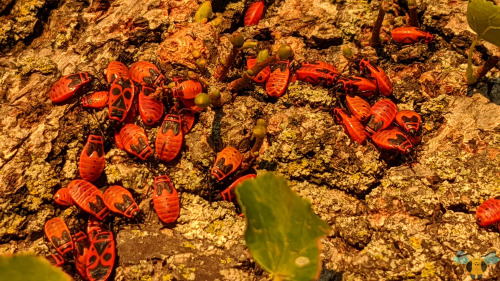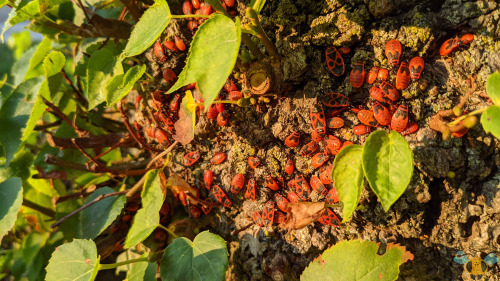#firebug aggregation
Firebug (aggregation) - Pyrrhocoris apterus
Valentine’s Day may have been yesterday, but we can still celebrate the day after with pictures of some delightful insects. Or perhaps, a whole army of them nestled in the sunlight and in the roots of this tree! It’s never easy to choose a red insect for such a day. Having already used the Red Milkweed Beetle and the Red Admiral to celebrate, I thought this year I would go with a very prominent and common Red Bug. Literally, for this Red Bug is indeed a Red Bug of the family Pyrrhocoridae, some of which are called stainers. Many of the insects in this family have beautiful red patterns (sometimes on the underside) highlighted with black markings. Here we find many individuals with these patterns in the different stages of their life cycle, though most are sub-adults, waiting for their final molt into winged adult. For the former, you can tell by the presence of black-colored wingbuds and a row of spots running down the abdomen of the Bug. Unfortunately things don’t really improve on the wing front (unless very lucky) into adulthood as Common Firebugs have reduced wings, compensated by a solid running speed. Though this aggregation looks intense for the afflicted tree, there is likely little danger to it as these insects feed on seeds and fruit.
This tree is likely just a resting spot for these insects to settle in after the sun sets. There are plenty of nooks and crannies to hide in until the next day. They likely aggregate together for the safety in numbers while waiting to fully mature. After mating, most of them will likely go their separate ways to place eggs in optimal locations. Sometimes that means a warm house interior, but they’re just doing what they do, and while they can seem like pests, they aren’t dangerous at all. If you find any in your home or garden, I don’t recommend crushing them, for you see they don’t find each other by running around and bumping into one another. They communicate using scents and chemical markers in the form of pheromones to bring everyone within range to the safe haven. Squishing them may only release more of the pheromone and invite more guests and/or suitors to the party! It may also leave a nasty stain behind too, which exemplifies the “stainer” name. The insects will need to be relocated and the area rinsed of pheromones if you don’t want them coming back. Gardeners may consider using the hose to get rid of them, but I think these insects are alright and it’s both interesting and amazing to see such a level of aggregation (and teamwork to some extend) in insects outside of those in a colony or a gregarious swarm.
Hope you all had a wonderful Valentine’s Day!
Pictures were taken on August 27, 2020 with a Google Pixel 4. These insects can also be seen in 2 videosuploaded earlier.
Post link










